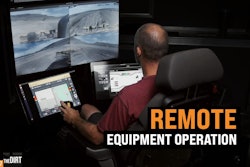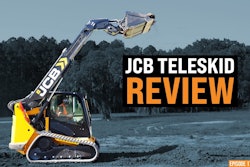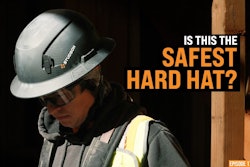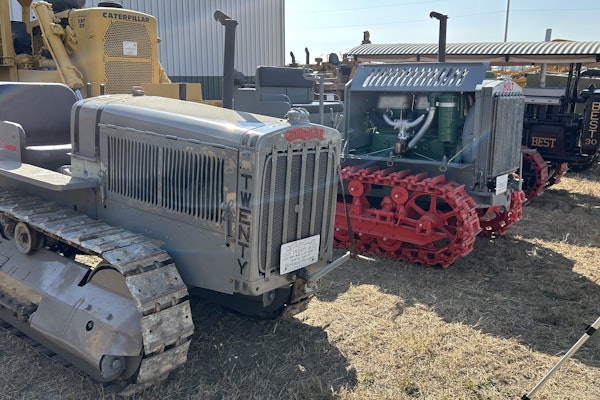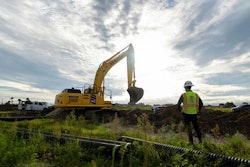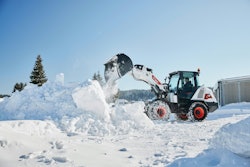JCB came out with the market’s first all-electric compact excavator in 2019. Five years later and 1,200 machines produced, we check in to see how the 1.9-metric-ton model is doing and what it’s like to run the 19C-1E.
Host of The Dirt and professional operator Bryan Furnace first takes us on a walkaround tour of the electric mini excavator led by JCB product manager Lee Tice. After that, Bryan hops in the cab to do some digging in Savannah dirt.
He gives us his impressions of the excavator’s performance, including how it stacks up to a diesel machine. He also gets answers to the questions contractors are most likely to ask when it comes to battery-powered equipment. The first being: What’s the runtime?
So to find out what’s it like to run an electric excavator, its pros and cons and whether it’s something that could fit in on your jobsites, check out the latest episode of The Dirt.
Equipment World serves up weekly videos on the latest in construction equipment, work trucks and pickup trucks – everything contractors need to get their work done. Subscribe and visit us at equipmentworld.com!
In This Episode:
- 00:00 – JCB 19C-1E Electric Mini Excavator Overview and Review
- 00:44 – Equipment Walkaround
- 01:40 – Power and Hydraulics
- 02:44 – Dig End Maintenance and Pin Size
- 04:01 – Charging and Side Door
- 05:54 – Machine Weight
- 06:40 – Counterweight
- 07:02 – Service, Repairs and Warranty
- 10:14 – Rear Compartment
- 12:04 – Tie-Down Points
- 12:16 – Cab and Operation
- 14:30 – Review
- 15:53 – Machine Noise
- 17:07 – Instant Power
- 19:01 – Charge Time
- 20:52 – Track and Dozer Blade Adjustability
- 21:32 – Cab Layout and Size
- 22:45 – Runtime
- 24:32 – Final Thoughts
00;00;00;12 - 00;00;23;11
Bryan Furnace
Today we're here to talk about some electric equipment, but this time is going to be a little different because I'm actually running it and we're going to do a review. We're talking about JCB Electric Mini Excavator, and we're going to do this review just a slight bit different than the ones we have in the past.
00;00;23;15 - 00;00;49;07
Bryan Furnace
The first part of this interview is actually going to be me walking around the machine with the product expert, because I really wanted to capture some of the dialog that happens before I actually enter and run the machine. And then from there, we'll move into our kind of standard equipment review. So all that being said, enjoy.
00;00;51;21 - 00;01;13;10
Lee Tice, JCB product manager
So 19 C1E okay. launched in 2019 for JCB. So it was the first electric mini excavator on the market. Real big thing about this machine is going to be no compromise from its original counterpart. So JCB designed it. We designed it. So you get all the same performance that you would get out of the diesel machine. Zero emissions, low noise package.
00;01;13;10 - 00;01;32;23
So that's the real big thing there. So all the features that come along with that diesel machine. So 13ft a dig right at nine feet of load over height. Same machine footprint. So still a 1.9 mini excavator compact size. So that's the real big thing going to the electric machine that we like to point out first is that you're not losing anything.
00;01;32;23 - 00;01;52;09
Yeah. By going to an electric package you're really gaining that zero emission low noise and opening up doors for different applications. Just out of curiosity, with the electric motors, are you guys able to actually get more power out of the machine? or is or is your restriction the hydraulics really at that point, your, your tear out forces and all that, it's going to be right on par with the diesel machine.
00;01;52;09 - 00;02;09;22
So, right at 4000ft pounds of tear out force on the bucket, what you will get is more responsiveness. Yeah. So we're a diesel machine. You're having to spool that engine up, get that RPM to get the motor spinning. Are the hydraulic pumps. Yep. With the electric it's all proportional to that joystick. Yeah. So you will feel more responsiveness out of an electric machine.
00;02;09;22 - 00;02;24;05
And you've got auxiliary hydraulics on that. Yeah. Got auxiliary hydraulics. So you can run you can put a thumb on the front. You can put breakers on it. That's a big one where you get some of these indoor applications where you're having to go excavate to get to utility work inside of a retail store, whatever it may be.
00;02;24;05 - 00;02;43;12
Yeah. so you can put a breaker hydraulic attachments on the front. Just out of curiosity, what does that do to your battery time. So it will decrease your battery time running continuous flow on. Yeah. On your hammer is a pretty drastic. It's not as drastic as you would think. Okay. So I'd say continuous. Your run time is going to go from a five-hour continuous down to about a three-hour continuous.
00;02;43;12 - 00;03;03;21
Oh that's not horrible. So big thing on our mini excavators as well. It's going to be what I'm holding here in my hand. So bronze graphite impregnated bushings 500-hour greasing interval on the dig into this machine. Wow. So that's literally graphite. Just chunks of graphite in there. And as it wears obviously it's just sloughing off just a little bit.
00;03;03;21 - 00;03;19;03
And it mixes with the greases in the bushing. And yeah interesting. So that's really big for the customer. That's kind of on the go. Or maybe some of these rental contractors, rental companies. Yeah. Where the machine may go out on an extended rental, obviously they're going to grease it when it leaves that facility, but who knows what the customer is going to do once it gets on the job.
00;03;19;03 - 00;03;37;12
So never touch it with a gun. Right? For the most part. But, from a longevity standpoint, serviceability, 500-hour greasing. So that's a big one we like to harp on on the dig into the machine. Yeah. So that is every fitting out here on the arm. Yep. 500 tired dig in 500-hour greasing interval. So but you can still grease it like you do a traditional machine.
00;03;37;12 - 00;03;53;27
It's not gonna hurt you. You're not going to hurt anything to grease it a little more. But, and I'm assuming it's like any other situation when they get all warmth out now instead of lime borne, you're just popping bushing, not replace bushing. Yeah. It's interesting on the dig in 30-millimeter pins for the attachment. Okay. This is pretty industry standard.
00;03;53;27 - 00;04;15;24
So if customers using x, y Z brand same same attachments are going to carry over to this machine. So. So inside of here we're going to have our charge controllers obviously orange cabling just like the EV world. So all your high voltage cabling is going to be identified with orange cabling okay. Hydraulic site glass all visible through this door here.
00;04;15;27 - 00;04;40;24
Charge filters all of those. And then our charge port. So this is going to be our standard charge port for using 110 or 220 okay. So this is our 110-volt cable. all machines will come standard 110-volt cable. 220 cable is optional. You can order it with the machine. Okay. but everything comes standard 110 and it literally just plugs in there.
00;04;40;27 - 00;04;57;16
You lock it down, plug that into any residential hundred ten-volt outlet, and it just automatically turned and it's going to start charging. you do have a charge indicator. So if this was plugged in there'd be a green flashing indicator right here okay. So light's going to flash green while we're charging. As soon as we get to our full charge light's going to go solid okay.
00;04;57;17 - 00;05;15;24
If there's an error of some sort. So something on your house is messed up. We're not getting full power to this machine. Yep. Light's going to go red. Just let us know. Hey, we've got an error here. Yeah, something's going on. So, but pretty straightforward charging process where you just plug the machine in. You don't have to do anything exotic to to charge it, plug it in.
00;05;15;24 - 00;05;33;20
It starts charging and when you're done, we remove the cable, put our cat back on, and we're good to go. we cannot run this machine tethered. So there are some electric products in the market that will run tethered. This one is not made to run tethered. We want it to be the same experience that you would have on a diesel machine.
00;05;33;20 - 00;05;53;11
Right. And this is lithium-ion battery. Lithium ion. There are four cells in this machine for individual packs okay. So 24kW of power that is the same as the diesel engine. Interesting. So okay same if you do your horsepower conversion. Yep. Yeah. It's it's identical to the diesel. It's obviously electric. So it's measured in kilowatts. Yep. but that's the same as the diesel engine.
00;05;53;11 - 00;06;14;26
Yeah. What is the weight comparison of this guy compared to the diesel counterpart. Yeah. Good question. So obviously it's mini excavator. Large excavators are kind of rated in their overall tonnage. Same thing applies. So this machine is a 1.9 tonne machine. It's diesel counterpart. It's a 1.9 tonne machine. So weight right there is right on with its diesel counterpart.
00;06;14;26 - 00;06;33;14
Just because if it was heavier than diesel we'd have to call this a two point. Yeah, two tonne machine instead of a 1.9 tonne machine. So just out of curiosity, with the weight of battery packs and the electric motors and everything, are you guys finding that you actually have to use less counterweight because the machine itself is heavy?
00;06;33;14 - 00;06;50;16
Or is the counterweight roughly the same on counterweights identical to it? Is it really? Yeah. So what kind of stuff right here not show that off. So this is full rear counterweight okay. Same counterweights on the diesel machine. Yep. And it's really from removing the engine to this machine to putting in the batteries and the charge controllers and all of those things.
00;06;50;18 - 00;07;12;03
We're right there. Neck and neck. No. no need for additional counterweights or removing counterweights, putting smaller counterweights on it. So it's really, a lot of thought went into it to keep it like for, like with that diesel counterpart. Yeah. Now here's a question out in the wild, just out of curiosity, how hard is it to find somebody who can work on one of these when you know, when you've got an issue?
00;07;12;04 - 00;07;35;23
Because it's really easy to find a diesel tech. But yeah, what we're kind of getting into electrician territory with the new machines, all of our dealer sites are trained to work on the electric machines, but we're not seeing a lot of need for service on our machines. So like I said, this machine launched in 2019. We're kind of five years into it, which is kind of where we start watching really close, saying, hey, what's what's the battery fall off doing those things?
00;07;35;25 - 00;07;50;24
We don't have claims on replacing batteries at this time. So. So that was my next question is on the battery packs. I think that's a big, you know, even on the EV market. Yeah, that's the big question mark is battery replacements. What is that going to look like. Have you guys started to see any. And that's what we're at.
00;07;50;24 - 00;08;09;10
We're hoping to work watching it and kind of seeing where that goes. So our batteries do have a five-year warranty okay. on the first machines we're actually hitting that mark of five years. So we're monitoring it really closely. But we're not seeing big uptake in battery replacements on machines past that five-year mark also being for individual packs.
00;08;09;10 - 00;08;28;14
So all four batteries so you don't have to replace the whole shebang. It's literally one one pack. And you can see them somewhat right here. so you can see oh yeah, that's a cell. That's a cell. Yeah. so it's individual packs. Okay. It'd be a rare occasion for all four of those packs to just fail at one point in time.
00;08;28;22 - 00;08;48;22
So we're just monitoring now, since we crossed that five-year mark on the early machine, seeing. What does this look like? Where does it go? so, so far, seeing great results out of them. Machines still running strong in the field for 2023. We had our one thousandths machine there. At this point we're at about 1200 of these out in the wild.
00;08;48;25 - 00;09;16;18
so pretty good sample size out in the field. And yeah, the ones we have seen, that need replacements in the field are typically from operator, abuse, abuse. So I was trying to think of. Yeah, a kind of a polite word there. but yeah, we'll say abuse. I mean, because there is a kind of a recommended maintenance or operating procedure for the electric product is a little different than a diesel counterpart, where diesel machines, you can run that thing, say your fuel lights on it.
00;09;16;18 - 00;09;35;21
With these machines, you really don't want to deplete that battery all the way to zero. That's the real way to harm an electric vehicle is by depleting the battery. And that's no different from electric vehicles and cars. And yeah, same old construction equipment. You don't want to run that battery down. If I pull in driveway every night and leave the headlights on on my pickup truck.
00;09;35;23 - 00;09;56;01
Yeah. Eventually buying a new battery battery's going to take a beating. same thing applies here. We have built safeguards into the machine. Okay. To try to prevent some of that. So at 10%, this machine is going to start giving you an audible alarm saying, hey, something needs to happen. Yeah. It also reduces power. Oh okay. Once you get to 5%, you're going to go to an idle speed.
00;09;56;04 - 00;10;14;24
You're going to have a constant audible alarm saying, okay, I need to get to a charger. So we did try to build some safeguards in there to really keep that operator mindful of running that battery all the way down to zero, keeping that recommended charging procedure. And operators always listen to alarms. Yeah. Oh, it's always so back here.
00;10;14;24 - 00;10;34;03
Obviously, a lot of orange cabling charge controllers back here. Battery isolator is another one. This is something that JCB puts on every machine we have. Yep. You're going to have a battery isolator is going to come standard. This machine is being left on remote job sites. Whatever it is. you can throw the switch and put a lock through there, prevent vandalism, whatever it may be.
00;10;34;05 - 00;10;50;14
No one's gonna be able to get in here and mess with the machine while guys at home. Contractors at the house, whatever. Yeah. Rapid charge report. If the customer's needs dictate, he needs that rapid charger. So maybe he's running three shifts, and he needs to charge this machine every two hours. Whatever it is. Yep. Rapid charger port comes standard.
00;10;50;19 - 00;11;11;20
Okay. All machines. So it doesn't have to be something the machines got to be ordered with. It's going to be standard. It's there always. And then pattern changeover switches back here. So it does have pattern change over okay. That's kind of the rear of the machine here. We did take those batteries. We got some feedback that said our customers do not want these batteries easy to get to.
00;11;11;22 - 00;11;32;20
So obviously it's an expensive item. So you think about people taking catalytic converters and theft and things like that off a diesel machine. Our interest. So like electric batteries obviously, high value items. Yeah. If we make them easy to get to, they can potentially be removed from job sites or remote locations, things like that. So we did tuck them in here quite a bit to kind of protect them, prevent theft and things like that.
00;11;32;22 - 00;11;57;11
So what is the process to get the battery packs out? Is it coming out the back or is it coming through the kit. They'll come out the rear of the machine. Okay. So this counterweight actually does a bolt. There's a single bolt right here okay. Remove that bolt. This entire counterweight will swing open. Oh wow. Okay. So once that counterweight swings open, you then have access to your high voltage batteries.
00;11;57;13 - 00;12;17;01
Your 12-volt battery is also down here. Okay. So you then have access to all your batteries, serviceable items things like that. So also tin tie down points around this machine thing. So a lot of tie down points on it. Yeah. Just depending on trailer configuration. Obviously 1.9-ton machine can be transported on a variety of trailers. Yeah.
00;12;17;03 - 00;12;35;18
All right so it's been around talk cab for a minute okay. No different than the diesel cab. Yeah. So same cab with the few minor tweaks obviously for the electric machines display is going to be a little different on this machine kind of obviously battery life not fuel. Yeah things like that. So we do offer it in a cab or canopy okay.
00;12;35;21 - 00;12;54;11
Canopy machines will not have air conditioned at this time. Okay. So that's the big kind of caveat there. Startup procedure pretty straightforward. So you can turn that key one position. This gauge is going to come to life. You hear the machine beep. Just take that key like act like you're cranking it. Just hold it. You're going to see a blue light over there by your hand.
00;12;54;14 - 00;13;15;01
It's going to illuminate once that blue lights on machine is live. Okay. So you do still crank it over like you're doing a diesel engine. So it's still got that same feel about it. Yeah. Once that blue light comes on now all of your DC to DC converters relays are energized. You can drop that left hand pod. So your RPMs.
00;13;15;01 - 00;13;34;04
Instead of talking about engine RPM, I'm assuming now we're talking about pump and motor RPMs. So we're interested in an electric motor. Yeah that's that's your RPM. Okay. all JCB mini excavators will have what we call a safety to go switch. So it's just a safety interlock. It's going to be that top left-hand button there on the membrane keypad.
00;13;34;04 - 00;13;46;19
So see it's got a lock and a joystick. Yep. You push that you hear the machine beep. Yep. This machine is now live. Controls are active okay. So if you were to pull back on your right stick.
00;13;46;22 - 00;14;04;18
Well that's that's what we get our RPM. So like we talked about that is going to spin that electric motor faster. You hear it idle down there after three seconds of no movement the machine will actually idle down. Interesting. So that's a battery saving feature that's built into the machine. Yeah. So as you're sitting there, we are having this conversation talking about our job that we're doing.
00;14;04;18 - 00;14;25;04
The machine just idles itself down as soon as you touch the controls. Interesting. So if I'm not using a function that requires pumping of hydraulics, it's still not going to correct. Interesting does have two speed, just like the diesel machine. Okay, it does have an auto kick down feature, so it will kick down as you turn. Obviously, we don't have foot pedals, so if you're turning pivoting it will auto kick down.
00;14;25;04 - 00;14;45;17
Bryan Furnace
But how other than that operation is going to be identical to the diesel machine. Interesting. I'm curious to get this out and play with it now.
00;15;07;03 - 00;15;29;21
Bryan Furnace
This is kind of an underwhelming review because I really went out there thinking, oh, this is a piece of electric equipment. There's going to be some really unique things about this machine that are going to stand out. And I will say, this is kind of where it's a true compliment to how JCB has implemented the electric technology.
00;15;29;21 - 00;15;44;29
Bryan Furnace
There really isn't a whole lot to it. It's a very straightforward machine. When you walk up to it, it's like any other 1.9-ton excavator out there. It's not like you're going to have to spend a bunch of time training your people on how to run this thing, or how it operates, or how to take care of it.
00;15;45;01 - 00;16;09;21
Bryan Furnace
The only difference between this and its diesel counterpart is the fact that it's run off of electricity and has batteries, instead of having a diesel engine in the back. And that's where we really get into what stood out about this machine is when you turn the key on and just listen to quiet.
00;16;09;24 - 00;16;30;28
Bryan Furnace
It's really quiet. All you hear is the electric whirring of motors and some hydraulic fluid moving around. Listen to the volume that I'm talking. And my videographer was out here a minute ago, and he was standing from me to where the bucket is. And still I'm talking at this volume because I'm not having to scream over a little engine going hog wild powering this thing.
00;16;30;28 - 00;16;58;09
Bryan Furnace
Instead, it's just you can hear the electric whine behind me that is the only sound associated with this machine outside of the actual bucket clanking. It is a game changer to be able to hold a conversation with someone ten feet 15ft away from you without yelling over top of the engine. It's very easy to hear feedback from your labor if you're exposing utilities or doing some delicate piece work where you need to be able to verbally communicate while operating the machine that just got ten times simpler.
00;16;58;16 - 00;17;27;05
Bryan Furnace
It is so nice not to have the engine screaming behind you in the cab. One of the things that's really unique about this machine compared to its diesel counterpart, is the way the controls respond in your hands. The only way I can describe it is it's a very linear feedback that you get from your joysticks. You were so used to a diesel engine where the diesel engine has to keep up with the power demands of the hydraulic system.
00;17;27;07 - 00;17;42;29
Bryan Furnace
There's a little bit of a lag that we as operators don't really think about, but it's there just like it is when you hit the accelerator pedal in your car. There's just this little bit of lag that we're automatically accounting for in our brains as we run these machines. With the electric equipment, you don't really have the lag.
00;17;43;06 - 00;18;01;21
Bryan Furnace
The power is instantaneous. As soon as I move my stick, my bucket boom stick is going to do whatever I need it to do. And there's not really any hesitation. And this is where it really gets interesting, is the amount of torque that these electric motors produce. I was able to set myself up with my bucket pretty much up against the cut.
00;18;01;21 - 00;18;23;28
Bryan Furnace
And really this was pretty sticky clay, and it was bogging the machine like it would any other machine. So what I did is I stuck my bucket right there at the edge of the clay, and I let the machine idle down because yes, this machine still idles down like its diesel counterpart, except instead of the diesel engine spinning down, it's literally the electric motor just coming down to a softer RPM.
00;18;23;28 - 00;18;44;16
Bryan Furnace
So you're not wasting energy. I'm going to let this idle down. And if you can imagine, when we start in a cut in relatively hard material with a diesel machine, that machine is not going to be able to go from dead stop to go. So here we go. Here we're going to start a pull up. I already have a full bucket.
00;18;44;16 - 00;19;07;01
Bryan Furnace
And it just now got up to speed like that's impressive. That's the power of electric motors over diesel motors. I would almost say at this point the limitation on the power output of the machine isn't the motor driving the system, it's the hydraulics in the system. Now let's talk about the actual training of what you're going to have to do to prep your jobsite to have one of these machines out there.
00;19;07;07 - 00;19;28;29
Bryan Furnace
Again, JCB has made this almost stupid simple. There's literally a plug on the side of the machine. Your machine will come with a 110 power cord that looks like an extension cord. You get out of your garage with a unique adapter on one end, you're going to plug it right into the wall. You plug it right into your machine, and that machine will go from absolutely dead to full charge in about 10 to 11 hours.
00;19;29;02 - 00;19;46;06
Bryan Furnace
Now, let's say you want to get a little more aggressive. We can't wait 10 to 11 hours. Now we need to step up to 220. If you have 220 available on site, guess what? Same kind of cord, same charging port. The machine automatically senses the change in voltage. You don't have to flip any switches. You don't have to worry about shorting anything out.
00;19;46;13 - 00;20;01;03
Bryan Furnace
You literally plug it in, and the machine does the work to figure out what it's being fed. And now your charge time drops to about 4 to 5 hours. But now let's say you need the Mac daddy of Chargers. You need this baby up and running all the time. That's where you step into the three phase 480 charger.
00;20;01;03 - 00;20;23;05
Bryan Furnace
And now you can charge that thing from dead stop to a full battery in just about two to 2.5 hours. So now you have the availability to really top this thing off during lunch breaks throughout shifts, and you can pretty well have that machine running 24/7 outside of your half hour to hour lunch break, where you need to top off the machine and let your operator take a break.
00;20;23;07 - 00;20;58;12
Bryan Furnace
It's actually pretty interesting how viable this technology is for a lot of contractors that are working in, you know, city or municipal projects where you're going to be around power consistently. I can also see this being a super viable product for if you're a demo contractor or something that does work for large retailers where they need to be up and running while you're continuing to work inside the building, well, now you have a machine that's ultra quiet, you have power readily available on site, so you don't have to worry about charging, and this thing is able to shrink its traction so you can fit through a standard 36 inch door, no problem at all.
00;20;58;15 - 00;21;17;08
Bryan Furnace
And so this is a really, really nice, compact little machine. But once you're on the jobsite, you're then in a position that you can expand them out and you have a nice stable work platform. You have wings on the blade that will also adjust to the width of your track. So if you have them all the way retracted, you can suck your wingtips in and really get skinny on the blade.
00;21;17;12 - 00;21;32;18
Bryan Furnace
But the flip side is when you have them extended out, you can pop out those wingtips, and now you're able to doze the full footprint of the machine. You also have features like the swing boom, which you're going to find on any other mini excavator, and every other feature that you pretty much expect to find on a machine this size.
00;21;32;19 - 00;21;53;25
Bryan Furnace
Now, the cab on this machine was laid out well, it was spacious. It's exactly what you would expect for a mini excavator of this size. It's not like you've got tons of leg room and room to sprawl out all over the cab, but at the same time, I did not feel overly cramped. It was quite comfortable. The controls were very ergonomic in the hands and they did make a sacrifice on having foot pedals in the machine.
00;21;53;25 - 00;22;15;02
Bryan Furnace
And I'm really torn on this because from one aspect, being a bigger guy, I got size 13 boots. Guys like, that's a big old boot to have in a cab of a little mini excavator. And whenever you have those tiny little flip up pedals, half the time your boots too big to really get a good grip on it to do what you want to do, or you're constantly getting the sole of your boot tangled on that pedal.
00;22;15;02 - 00;22;33;27
Bryan Furnace
And it's just irritating. But the flip side is there are certain applications where it'd be really nice to have those foot pedals. JCB opted not to go with the foot pedals on this unit, and I have to say, after a lot of contemplation and using the machine yesterday, I. I think I ultimately am glad they made the call not to put the foot pedals in on a machine that size.
00;22;33;27 - 00;22;52;14
Bryan Furnace
Most of the time, I'm not going to be in a situation where I'm needing to track and dig or do something with the arm at the same time, and to not have the extra stuff around my feet was actually really convenient. When it comes to runtime. That is the big question on everyone's mind. We've talked about charging, but we haven't talked about runtime.
00;22;52;16 - 00;23;15;05
Bryan Furnace
You're going to get about five to 5.5 hours of continuous use out of this machine, and this is where I need to just be very clear. That is continuous use, digging nonstop in hard conditions. That does not mean that if you take this machine out, you go install a sewer line. It sits out there for 45 minutes while you install your pipe.
00;23;15;05 - 00;23;34;29
Bryan Furnace
Then you bring it back, you trailer, you take it down the road to another job. You're not going to run out of battery in 5.5 hours. The 5.5 hours refers to actual running dig time, not idle time. So realistically, if you look at telematics data, which this is how these companies are kind of gearing, how much power they need to put it in the machine.
00;23;35;01 - 00;23;58;18
Bryan Furnace
Telematics data tells us that's about what a mini excavator spends running during a day, doing actual work. The rest of the time, it's either off or it's going to be idling, waiting for your labor to throw that pipe in the trench. And that's where we do need to be very clear. With any electric equipment going forward, you need to view the runtime time as actual runtime, not how much of your workday can you utilize the machine?
00;23;58;18 - 00;24;21;21
Bryan Furnace
That's not the same thing now. I spent about 45 minutes to an hour digging in pretty rough clay, doing a fair amount of dosing with the blade just to get a feel for the machine. And I noticed we used about 15% of the battery. Now, if you start getting in negative temperature conditions, you're going to notice a fairly decent drop off in battery life, as well as if you start going over about 110°F.
00;24;21;21 - 00;24;36;28
Bryan Furnace
You're going to also notice that the battery starts to drop off as well. So that is again, one of the limitations of electric equipment in its current form is you do have to worry about the extreme temperatures.
00;24;37;01 - 00;24;57;19
Bryan Furnace
Overall fantastic little machine. I really enjoyed running it. It's not going to require any special training to your employees. It fires up the exact same way its diesel counterpart does. You literally can throw an operator into this machine, and within 30s, he'll be able to familiarize himself with the controls with the cab layout, and he will be at work with no problem.
00;24;57;21 - 00;25;15;21
Bryan Furnace
So it's really implemented in a great system to make this transition period a little easier on the workforce, and I'm excited to see where the industry goes as more electric equipment gets introduced into the marketplace. So as always, I hope this helps you and your business. We'll catch you on the next episode of The Dirt.
